#house of orleans-braganza
Text

Queen Maria Amalia of the French with two of her grandsons: Prince Gaston, Count of Eu (future Prince Imperial of Brazil by marriage) and Prince Ferdinand, Duke of Alençon.
#queen maria amalia of france#gaston count of eu#ferdinand duke of alençon#french royal family#brazilian imperial family#french history#house of orleans#house of braganza#brazilian history
9 notes
·
View notes
Photo
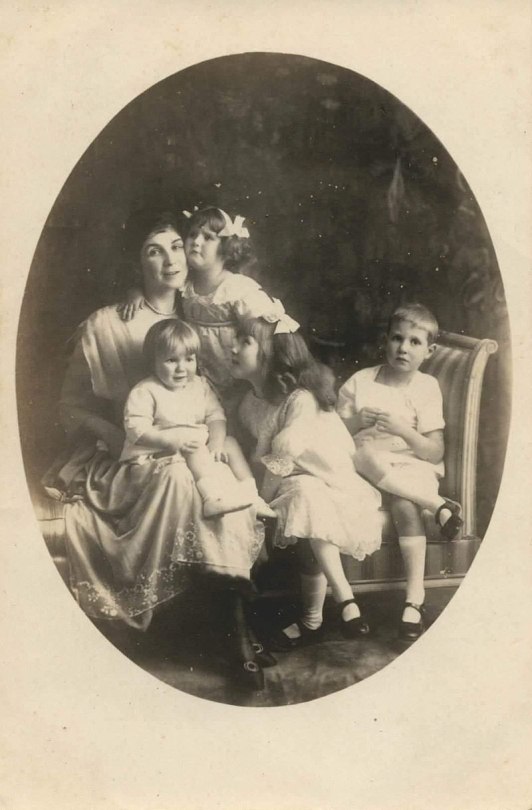
Princess Pedro de Alcântara of Orléans-Braganza (born Countess Elisabeth Dobrženský of Dobrženitz) with her eldest four children, Isabelle, Pedro Gastão, Maria Francisca and João Maria of Orléans-Braganza
#Princess of Orleans-Braganza#Princess Isabelle of Orleans-Braganza#Countess of Paris#House of Orleans#House of Braganza#french royalty#brazilian royalty#Princess#History
12 notes
·
View notes
Photo

Isabelle d'Orléans-Braganza, Comtesse de Paris (1911-2003).
She was a French-Brazilian memoirist and consort of the Orléanist pretender, Henri, Count of Paris.
She was the eldest daughter of Pedro de Alcântara, Prince of Grão-Pará, erstwhile heir to the throne of the Empire of Brazil (he was the eldest son of Isabel, Princess Imperial of Brazil, the elder daughter and heiress of Emperor Pedro II of Brazil, and Prince Gaston of Orléans, Count of Eu, grandson of Louis Philippe I), and his wife, Countess Elisabeth Dobrzensky of Dobrzenicz.
#royaume de france#maison d'orleans#bourbon orleans#isabelle d'orléans#comtesse de paris#orleans braganza#orleans bragança#house of orleans braganza
10 notes
·
View notes
Photo
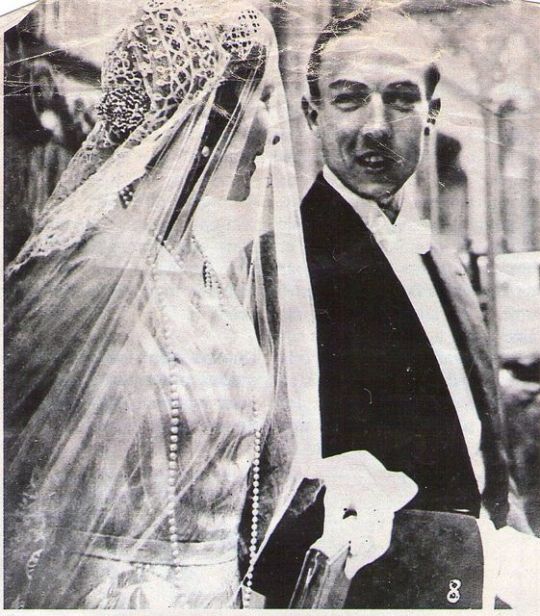
✵ April 8, 1931 ✵
Princess Isabelle of Orleans-Braganza & Prince Henri, Count of Paris
#princess isabelle#prince henri#count of paris#countess of paris#house of paris#orleans-braganza#house of orleans-braganza#lace wedding dress#wedding dress#royal wedding dress#wedding veil#royal wedding veil#pearl necklace#pearl jewelry#france#french royal family#french royalty#french royal wedding#house of orleans#Royal Wedding
20 notes
·
View notes
Photo

The Count and Countess of Paris descend the staircase at the Royal Palace of Athens during the pre-wedding ball of the Prince of Asturias and Princess Sophia of Greece, 1962.
#french royalty#house of orleans#henri of orleans#isabelle of orleans braganza#comte de paris#comtesse de paris#royal jewels
72 notes
·
View notes
Photo

The young Queen of Portugal, who is said to be by far the most capable and well-endowed mentally of all the late Comte de Paris' children, must be exceedingly pleased with her brother's engagement to an Austrian Archduchess. Though she married when quite a girl – the festivities attendant on her engagement and marriage, you remember, were the real cause of her unfortunate father's final exile from France – the young Queen Marie Amélie has remained a thorough Orleanist, and she has never given up the hope that her brother may yet become, if not King of France, at least King of the French.
No greater contrast could be found than that existing between the Queen-Dowager of Portugal, and her practical, shrewd daughter-in-law. Maria Pia was a Princess of the House of Savoy, and spent a fortune each year on her dress. Queen Marie Amélie makes all her own hats and bonnets, and early established a work-room in the palace at Lisbon, and there a Paris model can be exactly copied in as many different materials and schemes of colouring as is required. The Queen is a very handsome woman, and her fair hair and clear skin make her look still quite young in a country where women age with painful rapidity. She is devoted to her two sons, and, if only for their sakes, she will exert all her knowledge of the world and innate ability to save Portugal from the fate which seems likely to befall the little kingdom. Dom Carlos is said to have a great belief in the wisdom of his Consort, and they have made it a rule of late years never to simultaneously leave the country. This wise resolution imposes many privations on the young Queen. She is tenderly attached to her mother, and would, if it were possible, spend much of her time with the widowed Comtesse de Paris. It is very probable that the Duke and Duchess of Orleans will spend a portion of their honeymoon in Portugal, for Queen Amélie has always kept a very soft corner in her heart for her wild harum-scarum brother.
The Duke and Duchess of Braganza, as they were then, spent the first few years of their married life in the curious old Palace of Belem and it was there that their eldest child, the Duke of Beira, was born. The young Queen was at one time very anxious that her parents should spend their life of exile in Portugal, and Dom Carlos offered to place Belem at their disposition; but the Comte de Paris had a great affection for England, and he also foresaw the possible complications with the French Government. It is an interesting and somewhat significant fact that the Queen Marie Amélie has always remained in constant correspondence with her cousin Princess Waldemar of Denmark, the light-hearted French “Mademoiselle de Chartres,” who was such a favourite with the late Emperor of Russia.
While the court was surrounded by indifference and hatred, there was one member of the royal family who enjoyed the favor of the crowd – Queen Maria Pia. Married at fourteen, she came to Lisbon with all the glory of her father, Victor Emmanuel. She indeed played with the popular favor. Her prodigality is proverbial. Her treasury is depleted; she is troubled about it at times, but has not resolution enough to stop her expenditure. The people complain, but they do not want anything done about Maria Pia because she is a “true queen.” Above all, she is majestic. A true daughter of kings, she is good-natured and generous.
The Sketch 1896
14 notes
·
View notes
Text
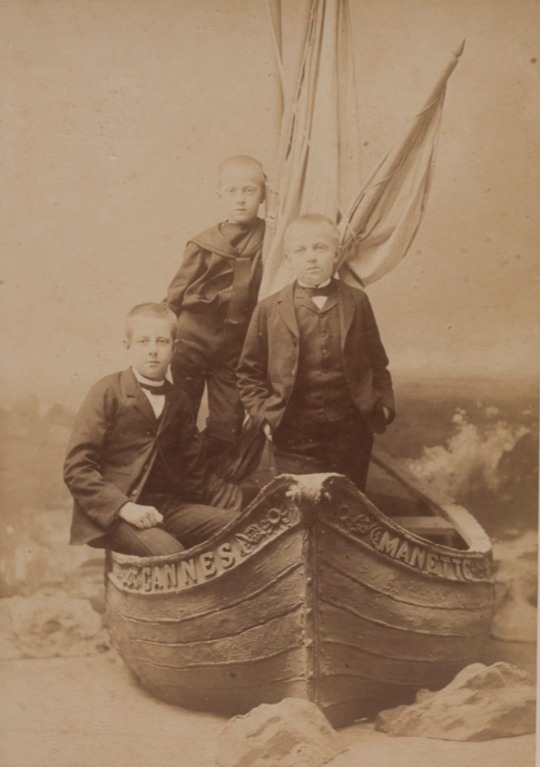
Brazilian Royal siblings, 1880s.
Pedro de Alcântara Prince of Grão-Pará (1875-1940), Prince Luís of Orléans-Braganza (1878-1920) and Prince Antônio Gastão of Orléans-Braganza (1881-1918).
#Pedro de Alcântara Prince of Grão-Pará#Prince Luís of Orléans-Braganza#Prince Antônio Gastão of Orléans-Braganza#orleans-braganza#orleans#braganza#brazilian royal family#1880s#brazil#house of braganza
32 notes
·
View notes
Photo
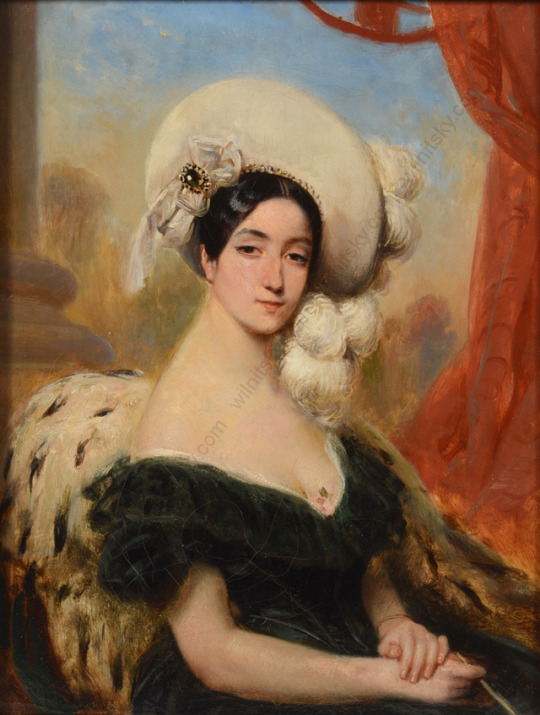
Francisca of Brazil, Princess of Joinville.
#Francisca of Brazil#dona francisca#princess of joinville#house of braganza#house of orleans#long live the queue
25 notes
·
View notes
Note
Hello Bamfsteel, since you already talked about Young Griff Blackfyre, and Daario Blackfyre theories, and there has been some debunkings on them, do you have any Blackfyre candidate or do you think the line of Daemon ended?
Hello, anon!
I believe many Blackfyre descendants are still around and will continue to be around by post canon. They are the parallels to the Targaryens who, despite the name having died out at the end of show!canon (and I’m sure will die out by book!canon), have descendants in the Baratheons (who will also survive through the illegitimate line), Martells, Velaryons, Longwaters, Plumms, Penroses, Hightowers, possibly the Tarths, possibly the Otheryses, and others (not counting Jon and the illegitimate children of Saera, Aerion, and Aegon IV +Maegor and Vaella since we don’t know what happened to them). It’s significant that despite these families all having Targaryen blood, they don’t consider themselves Targaryens and neither does anyone else (in fact, Jaime mocks Rennifer Longwaters for bringing up his distant ancestor Elaena Targaryen); their ancestry is, at most, a curiosity. That‘s how I think the assimilated current descendants of Daemon and Rohanne generally feel about their heritage, especially those descended from their daughters (Tyrosh is possibly matrilineal due to their custom of bride price/bride service); they are elite Tyroshi nobles who help choose the Archon, and aren‘t really interested in Westeros outside of trade. Due to the number of children Rohanne had, I wouldn’t be surprised if a few families of the elite could call her an ancestress. So I don’t think most of these descendants are relevant to the story.
Some theories about relevant Blackfyre descendants under the cut:
I mentioned this in the DaarioBlackfyre!Meta, but I think if any Blackfyre descendants actually appear in the storyline, it’s among the families of the Golden Company. The men I think make the most sense as Blackfyre descendants are Laswell Peake and his brothers, Torman and Pykewood. Laswell is one of the few officers referred to as a Lord, but an exiled one and not a Lord of Starpike; it’s likely he’s the legitimate heir to the Peakes of Dunstonbury (my opinion) or Whitegrove. His reference to “after 100 years, some of us still have friends in the Reach” and his brothers serving in the company indicate his family has been serving the the Golden Company for generations; we still don’t know how Gormon Peake learned about Daemon II’s plan for Whitewalls and coordinated it with him, but it’s possible that his exiled cousins told him. Gormon Peake was mentioned as a great knight and was a lead conspirator for the Second Blackfyre. We know that his ancestor Unwin Peake went through a complicated scheme just to try to marry his daughter Myrielle to Aegon III, so there could’ve been an attempt at a Blackfyre-Peake match. Along with from the Reynes, Brackens, Yronwoods, and Hightowers (none of which we know made it to exile, and had shaky support of the 2nd Blackfyre), the Peakes were the oldest, most powerful pro-Blackfyre House, which would make them a more plausible match with a Blackfyre than some of the other exile families. I’m saying that it’s not out of the realm of possibility for a Blackfyre Princess (maybe not Daemon’s daughter, but it could be the daughter of one of his sons) to have married the exiled Lord of Dunstonbury/Whitegrove. In real life, the descendants of deposed/exiled nobility can marry in order to keep their claims, rather than give them up to marry a commoner; for example, House Orleans-Braganza, descended from the deposed Princess Isabel of Brazil and the son of the deposed King Louis Philippe of France, whose line forbids morganatic marriages. Laswell and his brothers do want to make it back to Westeros, but if they are part Blackfyre, I don’t think they have interest in ruling anything except maybe their paternal inheritance.
Here’s a crack idea I don’t really believe, but it’s one I don’t think I’ve seen before: the paramour of Edgar Yronwood was a Blackfyre descendant. Edgar’s death seems mysterious and unjustified for such a minor dispute, so I feel there’s something more to the story. I’d like some payoff to the multigenerational pro-Blackfyre support among the Yronwoods, which went beyond ambition. It could be they were very good allies of Aegor Rivers (which seems to be the case), but I wonder if there were ever talks of a marital alliance. 13 years after Maelys’ death a marriage couldn’t happen, but a paramourship with future legitimization for her children might work (it’s also implied with Samantha Tarly/Lyonel Hightower that illegitimate children get legitimized if their parents marry). Again, I don’t really believe the paramour was a Blackfyre descendant—although I would like to know her name and why Oberyn wanted to make sure Edgar died in their duel, if she’s not going to show up again—since this theory really raises more questions than it answers. But a little speculation on a minor story while we’re waiting for the books to come out never hurt anyone.
19 notes
·
View notes
Photo
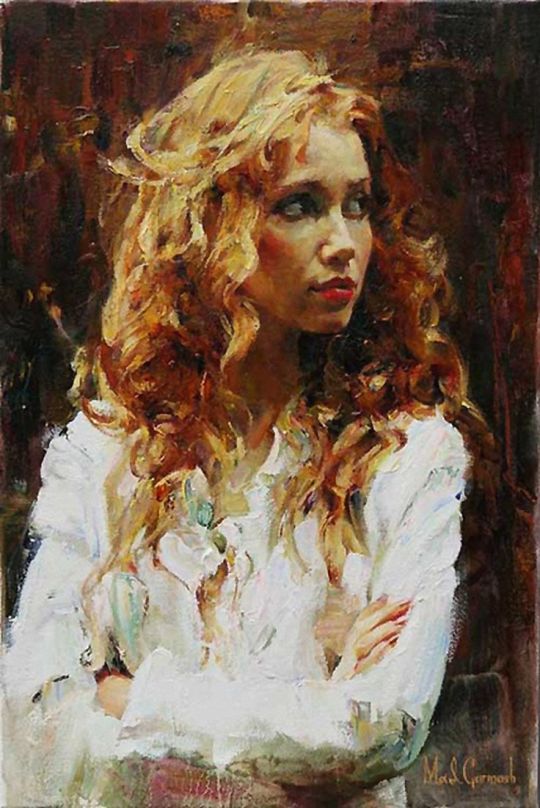
Biography of Queen Isabella
Early Life
Born 1 November 1992 in Geneva Switzerland to Archduke Carl Christian of Austria & Princess Marie Astrid of Luxembourg later Archduchess Marie Astrid of Austria. Archduchess Isabella Maria Anna Charlotte Elisabeth Ingeborg of Austria was the 5th of what would later become 6 children. With an older sister, three older brothers, and a younger sister Archduchess Isabella's life was filled with many close family members. Archduchess Isabella was christened in Zwiefalten Abbey in Baden-Wuttermberg, Germany. Her godparents were Queen Fabiola of the Belgians, Alois, Hereditary Prince & now Regent of Liechtenstein, and Maria Teresa, Hereditary Grand Duchess of Luxembourg then The Grand Duchess of Luxembourg. Two are usually chosen to be godparents, but Maria Teresa, later The Grand Duchess of Luxembourg was added to be a godparent after saving Archduchess Marie Astrid's life during her pregnancy with Isabella. Upon her baptism, Queen Fabiola of the Belgians called her "petite reine" which a nickname that her grandmother Josephine Charlotte, Grand Duchess of Luxembourg picked up soon after. Isabella grew up in Geneva with 5 other siblings while her father was a banker and her mother worked for the Luxembourg Grand Ducal Family as the daughter of the Grand Duke of Luxembourg.
Isabella's childhood was spent with her 5 other siblings, parents, and over 3 dozen cousins from Liechtenstein, Austria, Luxembourg, and Belgium. Her childhood was spent in Switzerland with holidays to Luxembourg, France, Spain, and Belgium. She spoke German and French in her early years and learned English and Spanish as a young girl. Though she does speak Dutch, Luxembourgish, Russian and Italian, those are not fluent languages that Isabella uses often. Isabella was sent to a boarding school in Kent, England where she was educated for 4 years until moving to Virginia, United States to another boarding school. Isabella went to Sevenoaks School in Kent, England alongside Prince Amedeo of Belgium, Archduke of Austria-Este and Princess Luisa Maria of Belgium, Archduchess of Austria-Este.
Archduchess Isabella went to Yale University and graduated in 2014 with a Master's Degree in Global Affairs and a Bachelor's Degree in Political Science. Her summer's during college where spent in third world nations with 2 different humanitarian groups alongside her cousin Princess Alexandra of Luxembourg. After her graduation Isabella immediately returned to Geneva where she began working for her father only to leave that job a couple of weeks later and began her work with the United Nations as a Human Rights Officer.
Marriage
Mid 2016 it was revealed that Archduchess Isabella of Austria and Prince Harry of Wales were well into their own relationship that was reported to have started in November of 2014 while Isabella was working for her father. This would later have said to be false but none in the British Royal Family would confirm if the marriage was indeed arranged at the time.
Prince Harry and Archduchess Isabella announced their engagement in January of 2017 with a wedding to be in the summer of that same year. The two became engaged at Fischbach Castle in Luxembourg during the Christmas holiday in the presence of the Luxembourg Grand Ducal Family and extended family. The wedding took place at St. Paul's Cathedral with 3200 guests in attendance. A majority being over 500 descendants of Robert I, Duke of Parma, who was the twice great-great-grandfather of Archduchess Isabella.
The wedding party, was the largest ever seen in a British Royal Family wedding at the time. Excluding the maid of honor, Archduchess Isabella and Prince Harry had 12 bridal attendants, 6 boys and 6 girls, all godchildren and family friends of the bride and groom. The maid of honor was chosen as Princess Charlotte of Nassau, a first cousin of Archduchess Isabella and a great-great-granddaughter of King Alfonso XIII of Spain and Queen Victoria Eugenie. Other attendants included Princess Eleonore of Belgium, daughter of King Philippe and Queen Mathilde of Belgium; Countess Xenia von Coudenhove-Kalergi, Granddaughter of Vincenz Liechtenstein; Archduchess Maria Stella of Austria, Isabella’s niece by her brother Archduke Imre; Archduchess Zita of Austria, Great-Granddaughter of Archduke Carl Ludwig of Austria; Princess Florence of Ligne, Granddaughter of Alix, Dowager Princess of Ligne; Prince Gabriel of Nassau, son of Prince Louis of Luxembourg; Count Rodolfo Secco de Aragona, Grandson of Archduke Rudolf of Austria; Archduke Luigi of Austria-Este, Grandson of Robert, Archduke of Austria-Este; Prince Valerian of Lobowicz, Grandson of Andrea von Habsburg; and Japer Dyer, son of Mark Dyer. The wedding was estimated to be watched by over half a billion people, making it one of the most watched events in British history.
House of Habsburg-Lorraine and the main and cadet branches of the House of Bourbon made up a majority of guests as relations to Archduchess Isabella. Other German, Danish, Dutch, Luxembourgish, and Belgian nobility were also invited as family of bride.
On the morning of the wedding Prince Harry was made Duke of Sussex, Earl of Ross, and Baron Hartland. Because Isabella was born an Archduchess of Austria and her title being higher than that of a Duchess, Isabella was formally introduced as Archduchess Isabella of Austria, Duchess of Sussex, Countess Ross, and Baroness Hartland. Buckingham Palace then issued a statement that Isabella will still be addressed as Archduchess and not Duchess, but her titles by marriage will also be used when formally addressed.
Children
December of 2017 Clarence House released a statement that Archduchess Isabella and Prince Harry were expecting a child in the summer of 2018, later Prince Harry revealed that no one in the royal family knew per request to keep everything as quite as possible. Clarence House released a statement that Archduchess Isabella gave birth at Château de Belœil in the early morning of 24 of May. A statement was released of the two boys named Charles Henry Ferdinand Baudouin Jean Philip, Earl of Ross and Lord Albert Maximilian Christian Leopold Felix Ludwig. The Earl of Ross’s godparents included Mark Dyer, King Philippe of Belgium, Jake Warern, Princess Margaretha of Liechtenstein, Guillaume, Hereditary Grand Duke of Luxembourg and Prince Seesio. Lord Albert godparents were Princess Beatrice of York, Prince Henri Antoine of Ligne, Edward Lane Fox, Alexander Fellowes, Princess Sophie of Liechtenstein, and Princess Maria Gabriella of Orleans-Braganza.
With their birth, pressure was put on the British monarchy to make them Princes, rather than lord because their parents' marriage was dynastic to the older generation. Due to being the children of the Duke of Sussex, any children from their marriage were not given the title of Prince. All of Prince Harry's children born during the reign of their great-grandmother Queen Elizabeth II would have the title of Lord and Lady with the eldest son receiving the subsidiary title of Prince Harry, The Duke of Sussex. Jean, the former Grand Duke of Luxembourg advised his son, Isabella's uncle, Henri Grand Duke of Luxembourg, to recognize the Dukedom of Sussex into the Luxembourg nobility and allow them to have his great-grandchildren to have title of Prince and Princess. The Grand Duke of Luxembourg was to give all children of Archduchess Isabella, the title of Prince/Princess of Sussex in Luxembourg nobility. By government advisement, the Grand Duke did not bestow any titles.
A second pregnancy was announced in November 2018. During Archduchess Isabella's second pregnancy, Isabella and Prince Harry to moved out of Kensington Palace and to St. James’ Palace to accommodate their growing family. May 26, 2019 Archduchess Isabella gave birth to Mary-Astrid Jeanne Zita Ingeborg Josephine Christine Diane at Berg Castle in Luxembourg. Mary Astrid's godparents included Archduchess Marie Christine, Princess Luisa Maria of Belgium, Viscount Althrop, Princess Marie Gabrielle of Luxembourg, Sophie Countess of Wessex, and Arthur Landon.
During the early months of 2020, Grand Duchess Olga Petrovna of Russia, Princess of Prussia was found dead in a villa off the coast of Italy. Grand Duchess Olga and Archduchess Isabella had been second cousins and the unexpected death of the Russian Grand Duchess came to a shock to the Habsburg family. The younger woman had reportedly suffered a third miscarriage and in the state of depression had killed herself leaving behind a 2-year-old daughter, Grand Duchess Maria-Olga of Russia, Princess of Prussia. Archduchess Isabella attempted to adopt Grand Duchess Maria-Olga but was met with failure.
In March of 2021, Buckingham Palace issued a statement that Archduchess Isabella and Prince Harry were expecting a fourth child in the fall of the year just a year after Archduchess Isabella's grandmother, Archduchess Yolande of Austria died. Isabella gave birth to a daughter, Elisabeth Alexandra Gabriella Annunciata Charlotte Theresa on September 18 at Balmoral Castle in Scotland. This was Archduchess Isabella's third at home birth. Elisabeth's godparents were Archduke Alexander, Queen Elizabeth II, Lady Kitty Spencer, Princess Eugenie of York, Princess Charlotte of Nassau, and Charles von Straubenzee.
Archduchess Isabella gave birth to another daughter, named Alice Margaretha Yolande Sophia Louise Christabel on December 25, 2023 at Sandringham House in Norfolk. Alice's godparents were Archduke Imre, Princess Marie Gabrielle of Nassau, Archduchess Helene of Austria, Tom Inskip, Anne Princess Royal, and George McCorquodale. More children quickly followed including a second pair of twin sons, Robert Paul Christoph Sebastien Francis Constantin and Nicholas Xavier Gabriel Wenceslas Patrick Rudolf on November 1, 2023. Two more sons followed Joseph Arthur Edward Alexander Otto Ernst in July 4, 2026 and Michael Frederick Emanuel Vincent Thomas Johannes in June 20, 2027.
The large number of children caused minor public upset for a couple of years. King George VII, limited the role of Archduchess Isabella and Prince Harry including limiting their royal duties. After 2022, Prince Harry and Archduchess Isabella no longer received tax payer funding except when receiving compensation from representing the royal family. The family split their time between London, Scotland, and France where the younger children had been born.
Duchess of Sussex
Within months of her marriage, Archduchess Isabella proved to be a generous humanitarian, as her deceased mother-in-law Diana, Princess of Wales. Hurricane Maria during the 2017 Hurricane Season provided Isabella with a platform that expanded her patrons to include helping victims across the world of natural disasters. Isabella took a tour of The Caribbean, Mexico, and Southern United States for her first solo tour.
The Duchess of Sussex became a patron of over 30 charities shortly after her marriage including becoming joint patron of several of Prince Harry's patronages and others dealing with immigration, women's rights, natural disasters, and the arts.
Death of Queen Elizabeth II
On November 21, 2020, The Duke of Edinburgh died at Buckingham Palace in his sleep. Archduchess Isabella and Prince Harry moved into Windsor Castle from St. James’s Palace after The Duke of Edinburgh's death to stay closer to the Queen. The Duke and Duchess of Sussex became patron of many of the Duke of Edinburgh's charities as well as several of Queen Elizabeth's charities. With the Queen's health in question after the death of her husband, many believed that the British monarchy would be abolished in the event of her death.
Queen Elizabeth II died on December 17, 2021 at the Sandringham Estates in Norfolk, England. Upon her death, her eldest son Charles, Prince of Wales took George as his regnal name. With the death of Queen Elizabeth, all of the Duke of Sussex's children were given the title HRH Prince/ss of Sussex. The Duke of Sussex eldest children, the twins Charles and Albert, were just 3 years old. Soon thereafter, The Earl of Wessex was given the Dukedom of Edinburgh. The Duke of Cambridge was not given the title Prince of Wales, and the Duke of Sussex was not given the title Duke of York upon their father's accession for different reasonings. With King George VII's accession, the Sussex family toured North America on behalf of the king.
Reign of King George VII and William V
The reign of King George VII was a short eight years compared to his mother’s historic reign. King George died on March 1, 2029. William, Duke of Cornwall and Cambridge was to be named King William V. Days after the funeral, William issues letter patent taking his brother Prince Harry of his Royal Highness style and title of Prince of the United Kingdom. This change effected Harry’s children as well, making them styled as children of a duke rather than Prince of the United Kingdom.
The move proved to be unpopular with the general public and within the family. William removed the status of his cousins and uncles as members of the British Royal Family in an attempt to limit the House of Windsor to the descendants of the current king. This left William without family members to help him with the kingdom and commonwealth. Weeks of bad press had made put a strain on the monarchy and the government.
A constitutional change was suggested by King William to change the line of succession to just the descendants of the monarch, thus leaving thousands out of the line of succession. Because the line of succession was determined by an Act of Parliament in 1689 and 1701, Parliament would be the ones to change it in the less controversial way. The Prime Minister and Parliament agreed there would be no change in the line of succession.
King William tried to follow in the footsteps of King George V and his father King George VII in slimming down the monarchy. By taking away titles, William believed he was helping the monarchy and had his brother married a commoner, it would have been fine. But William’s sister-in-law was Archduchess Isabella, a relative to most of the European monarchies of Luxembourg, Belgium, Spain, Liechtenstein, and the Netherlands.
Advisors to the king suggested William abdicate in favor of his brother who was already living in France with his family but he of course rejected. By August, William was facing heavy opposition. The Luxembourgish court released a family photo of the descendants of Jean, Grand Duke of Luxembourg for the 10th anniversary of his death which include Prince Harry and his large family. Other members of the family include Luxembourg royals and the future Prince Consorts of Belgium, the Netherlands, Spain.
Just months into his reign, William was faced with the task of becoming King of the United Kingdom finding it overwhelming. He complained about his duties, finding it easier to take holidays with his family. Louise, The Duchess of Bedford, wife of the 15th Duke of Bedford and Mistress of the Robes to Queen Camilla commented on the new king.
“I fear the new king knows nothing on how to lead nor listen. It will prove to be disastrous within the next couple of months, no doubt shaking this country to its very core. I have made up my mind that the women in this family should rule instead for they are the only ones with sane minds.”
William’s fate was sealed by that photo and the public started to demand Harry as king. Harry had connections and the celebrations of weddings, christening, and parties with Europe’s royals over the years brought back the nostalgia of 19th century Europe. It was Queen Isabella who had given him these connections and they would be an easy reason for William abdicated.
The Duchess of Bedford was hinting at an abdication in her diaries and several weeks later, King William V did abdicate. William’s Coronation was made for March of 2030 but he abdicated on December 3, 2029 in favor of his brother Harry, Duke of Sussex.
Year of French Court
From the time William stripped his brother and his family of their titles, Archduchess Isabella immediately left London for France. Her family stayed in the Château de Chambord, that for several decades had been the property of Isabella. Days after losing the style of Her Royal Highness in the United Kingdom, Isabella threw a masquerade ball which attracted much press since a large number of royalty and nobility attended.
Lavish parties, famous guests, and endless nights had made the press dub King Henry and Queen Isabella’s time in France as the “Year of French Court”. This nickname was a contradiction since the time in France was actually 9 months and French Court refers to French Royal Court, the last of which was the Bourbon court of King Louis Philippe in the mid-19th century.
King William’s court was the English Court bringing up an old rivalry between the French and the English. Unlike King Henry, whose last French ancestor was Claude of Valois, mother to the Tudor dynasty, his wife Queen Isabella ancestor included all French monarchs, save the Bonaparte's, although all Bonaparte’s were related by marriage. Queen Isabella had been related to every French monarch from the King of the Franks, Charlemagne to the last Bourbon, King Louis Philippe.
King Henry and Queen Isabella and their time in France was met with both high criticism and high praise. As private citizens, they could spend lavishly, but the chances of them being monarchs with the same type of spending left people to doubt them. The Château de Chambord became a popular destination for foreign royals who spent days to weeks at a time with Isabella and her family. All of Isabella’s son and daughter-in-law’s spent time at the château.
Several locations had become popular in Europe including Cabasson, France where the Luxembourg Grand Ducal Family owned a villa; Prince’s Palace of Monaco in Monaco, and Pejačevič Castle in Croatia. Isabella’s time with her family had reminded many, especially historians, about the family gatherings that the Danish royal family had during 19th century.
Queen of the United Kingdom
Upon the abdication of King William V in 2029, Isabella became the first Habsburg consort since the 1554 marriage of Queen Mary I of England and the future King Philip II of Spain. The coronation intended for William was given to his brother. King Henry’s children were elevated to royal status again and the titles stripped away by William were given back including giving the Dukedom of Edinburg to Prince Edward again.
During the coronation at Westminster Abbey, the five eldest children Prince Charles, Prince Albert, Princess Mary-Astrid, Princess Elisabeth, and Princess Alice attended some of ceremony. During the photos all nine of their children were present. The coronation was attended by a large number of Queen Isabella’s family, many of whom were married to heirs and other foreign royalty.
William and his family moved to Scotland and hours before the coronation, it was announced that William would not receive a dukedom but styled as William Mountbatten-Windsor, 1st Baronet Mountbatten-Windsor of Inverness. It was a hereditary title but with little significance so William could not get a following to recover the throne. It was on the advice of the British government that the title was revoked at the end of the year so William became Mr. William Mountbatten-Windsor at the beginning of 2031.
After the coronation a tour of the Commonwealth realms was ordered with included all nine children of King Henry and Queen Isabella. Isabella’s ability to speak multiple languages and years of working in disaster relief had pleased the public who found the new king and queen more likeable. Tours of Africa and later North America had kept the new royal family busy in the first couple of years.
The death of Queen Camilla in 2025 during the reign of her husband, had left Isabella the undisputed matriarch of the British family. The children’s ability to speak no less than five languages had amused the public and immigrants who found speaking to royalty in their mother tongue comforting.
Between 2029-2052 Isabella’s family rose to more significance. In Belgium, her cousin Prince Paul Louis become Prince Consort of Belgium and Queen Isabella’s niece Beatrice married Paul Louis’s son, Leopold, Duke of Brabant. In the Netherlands, Isabella’s cousin Prince Leopold became Prince Consort of the Netherlands and her nephew Joseph was engaged to Leopold’s daughter Charlotte, Princess of Orange. In Spain Queen Isabella’s cousin Prince Jean became the Prince Consort of Spain. Queen Isabella’s nephew Count Leopold married Crown Princess Estelle of Sweden. Queen Isabella’s second daughter married Prince Franz Joseph of Liechtenstein, future heir to the principality. Her niece Victoria married Jacques of Monaco, who at the time was Hereditary Prince of Monaco then the next year became The Prince of Monaco. In Luxembourg, the country was ruled by her uncle Henri, cousin Guillaume and his child.
Perhaps the most importance was the reestablishment of the monarchy in Croatia and Russia. In 2035 after the assassination of President Vladimir Putin, the Russian people brought back the monarchy with Grand Duke George Mikhailovich of Russia as their Tsar. His eldest daughter Maria-Olga had married Queen Isabella’s second son Albert in 2038. Tsar George died in 2043 and his successor was his son-in-law Grand Duke Alexander, formally Albert. Queen Isabella’s role as mother to the future King of the United Kingdom and Tsar of Russia was a point in history no could have predicted. By 2045 Croatia voted overwhelmingly to bring back their monarchy as well with Ferdinand von Habsburg as their king. Ferdinand was married to Isabella’s cousin, Princess Charlotte for already 25 years producing five children, including 4 sons which mirrored Charlotte’s own life as the only girl.
Queen Isabella was consort to King Henry IX for 23 years before her death of Dec 29, 2052. The couple had been married for 35 years and had nine children together.
Assassination Attempt
While in Monaco in 2052 for the royal family’s annual holiday to Monaco, Queen Isabella had fallen ill delaying the British Royal Family’s departure from the Chateau de Chambord. The British Royal Family had stayed in France for another week before leaving to Monaco. By that time, many of the other European monarchies had left to the respective homes.
In the middle of the day a man managed to sneak into the Monaco Princely Palace in an attempt to assassinate Queen Isabella. The assassin wanted to kill King Henry and Queen Isabella believing the rightful King and Queen were William and Catherine. King Henry was not with Queen Isabella but with her niece Princess Gabriella and nephew by marriage Jacques, The Prince of Monaco.
Attempting to assassinate the king and queen, King Henry was with his younger children who had fallen sick after their mother. Queen Isabella was on a walk with her niece and nephew who was going to announce their own ninth pregnancy the day after. Queen Isabella was asked to be godmother to their ninth child. The assassin lunged for Queen Isabella with a knife only to be blocked by The Prince of Monaco. Amongst the fight, Princess Victoria ran for help but Jacques had been stabbed and later died in the hospital. Queen Isabella did not die that day but several months later, as she died in a car accident in France.
Romances
On January 1, 2034 the official biography, letters, and interviews of Queen Fabiola of Belgium were released to the public. A frequent mention in Queen Fabiola’s writing include her goddaughter and great-niece Queen Isabella had interested the public. In these letters and interviews Queen Fabiola mentioned the relationship Queen Isabella had with her double second cousin Prince Joachim of Belgium. It was revealed that Prince Joachim was Queen Isabella’s first everything.
“I pray to God that one day I will live to my petite reine marry a good man. Joachim is a sweet boy in love but I doubt they will marry. Belle is heard strong and filled with passion I doubt Joachim can keep her happy for very long.”
Queen Fabiola’s biography gave unprecedented knowledge on Queen Isabella’s childhood. Besides the mention of Queen Isabella, her family, especially her parents Archduke Carl Christian and Princess Marie Astrid were written and spoken about often. Pictures from Queen Fabiola’s family album confirmed the relationship between Queen Isabella and Prince Joachim during their teen years. It was not known when the relationship started or ended.
Queen Isabella’s marriage to Prince Harry, later King Henry IX came to a shock to many. The marriage was arranged but came to be a marriage of respect and admiration. After a couple of years of marriage, Queen Isabella began an affair with Count Johann Kinsky of Wchinitz und Tettau, a distant relative of Marie and Georgina, The Princesses of Liechtenstein and King Willem Alexander of the Netherlands. Count Johann Kinsky was a financial advisor to Queen Isabella working in France at Chateau de Chambord.
The affair lasted only a couple of months with it ending in Count Johann’s resignation from Chambroad and his elevation in the Liechtenstein princely family. Often speculated, Count Johann’s new position in Liechtenstein was a way of ending the affair and keep the counts silence too While King Henry and Queen Isabella marriage wasn’t the same after the first affair, it took years before she took another man as her lover.
It was not until after the birth of her last child, Prince Michael that Queen Isabella began a second affair. Heinreich Donatus, The Prince of Schaumburg-Lippe was a minor German prince whom Queen Isabella had met briefly years before. Common weddings brought the two together but Heinreich Donatus friendship with the Princes Wenceslas and Constantin kept him in closer ranger. Prince Heinreich Donatus moved from Germany to France near Chambord to be near the queen. The affair was brief, only lasting about 2 years before Queen Isabella moved on.
Maximilian, 9th Prince of Wied was introduced to Queen Isabella by Prince Heinreich Donatus in 2030. Prince Maximilian had been married and later divorced with 2 sons when he met Queen Isabella. Like Prince Heinreich Donatus, Prince Maximilian moved his family to France so he could be in close proximity to the queen. This affair had lasted a little over 5 years before Queen Isabella had gone back to Prince Heinreich Donatus. Between 2036-2040 Queen Isabella continued to her affair with The Prince of Schaumberg-Lippe.
Queen Isabella’s affairs were few and long. After 2041, Isabella remained faithful to her husband but damage had already been done. The couple lived separate lives, only coming together for family events and public engagements. Unknown to the public, King Henry and Queen Isabella spent much time apart. Unlike Count Johann and Princes Heinreich Donatus and Maximilian, an affair with Prince Joachim of Belgium was never confirmed, but highly speculated.
Legacy
Every monarch in Europe descends from Queen Isabella and her husband, King Henry IX. As her children, grandchildren, and great-grandchildren married into various royal families over the decades, almost every royal of a working monarchy, descend from Queen Isabella. King Henry IX and Queen Isabella had 9 children, 47 grandchildren, and 211 great-grandchildren.
Although having a large number of descendants, many of Queen Isabella’s family had converted to Catholicism thus baring themselves and their descendants from the British line of succession. Of her nine children, only four children and their descendants have succession rights. Two of her daughters and three sons converted to Catholicism shortly before each of their respective marriages.
One of Queen Isabella’s lasting legacy is her large collection of jewelry. Many of the tiaras in the Queen Isabella’s Fund came from donations by women such as Princess Charlotte Murat. Other pieces of jewelry were bought by Queen Isabella which were owned by various Habsburgs during the Imperial era.
Unlike her predecessors, Queen Isabella bought many jewels from the Gloucester, Kent, Fife, and Harewood families but they did not go back to the crown as they were personal purchases. Personal purchases meant they were to the Queen Isabella Fund to be used by her female descendants and not by the British royal family. This meant that all jewelry was not kept to Queen Isabella’s British descendants but could be worn by her other descendants in other reigning and deposed monarchies.
While most of the tiaras have not been shown to the public it is an estimated number of tiaras and jewelry by experts and the public. Queen Isabella’s female descendants had worn a large portion of the tiaras but dozens are still speculated to remain hidden from the public eye. Queen Isabella’s tenure as Queen Consort of the United Kingdom, she rarely wore tiaras belonging to the British Royal Family and preferred her own tiaras.
A documentary of the 100th anniversary of Queen Isabella's death revealed that the tiaras are organized in tiers. There is a total of five tiers that the descendants of Queen Isabella must abide by ranging from descendants who are queens, both born and married into, who come from non-dynastic backgrounds. Tier One is for Queen or Queen Consorts born of a dynastic marriage and marry dynastically. Tier Two is for Crown Princesses born of a dynastic marriage and marry dynastically. Tier Three is for Princesses born of a dynastic marriage and marry dynastically, daughters born of princesses belonging to Queen Isabella’s descendants who marry foreign counts, barons, or duke of dynastic background are also entitled. Tier Four is for female descendants who hold no titles. Tier Five is for non-dynastic in-laws from families who do not come from a royal or noble family.
Queen Victoria was seen as the beginning of hemophilia. The hereditary disease that helped bring down the Russian Imperial Throne and Spanish Royal Throne were passed through women. The disease took Queen Victoria’s son Leopold, several grandsons, and several great-grandsons. Through the decades, the disease made no reappearance but plagued the royal house through books and cultural depictions.
Queen Isabella was no exception in beginning her own hereditary trait, but this one was less deadly than the one Queen Victoria passed on. Partial or Central Heterochromia is an eye condition where areas of the same iris contain two completely different colors or there are two colors in the same iris. The disease could be passed through males or females and in the case of Queen Isabella, she passed it on to her daughters Princess Mary-Astrid and Princess Alice along with her sons Princes Nicholas, Joseph and Michael.
By 2150, the hereditary disease was prominent in all monarchy finding the carrier was Queen Isabella. Queen Isabella herself had a faint case of Central Heterochromia though it is not clear which parents she got it from. The mismatched eyes became a physical staple of 21st and 22nd-century royalty.
10 notes
·
View notes
Text
Thank you😁❤️❤️❤️❤️
Royal sapphire tiaras
George VI victorian suite tiara
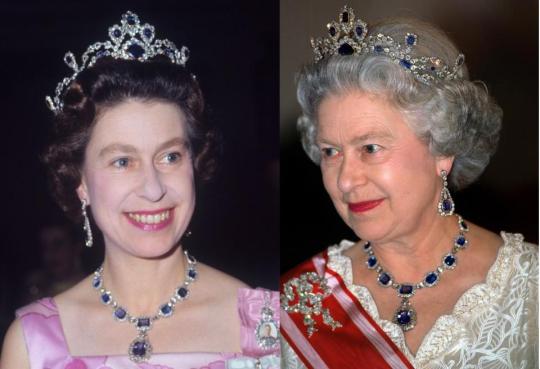
When Queen Elizabeth II was married in 1947, her father, King George VI, gifted her with the George VI Victorian Suite, a jewelry set consisting of a magnificent necklace and earrings composed of blue sapphires surrounded by diamonds. In 1963, the Queen commissioned a tiara and bracelet to match, which equaled in grandeur the decadent design of the set and the quality of the gemstones. The tiara is reportedly made from a necklace that originally belonged to Princess Louise of Belgium.

The Leuchtenberg sapphire parure tiara

Queen Silvia Of Sweden
The creation of the Leuchtenberg Sapphire Parure is attributed to Marie-Étienne Nitot, the official jeweler to Emperor Napoléon I and founder of the House of Chaumet. The blue sapphires used in the set are believed to have been a wedding gift from the Emperor to Princess Augusta of Bavaria, Duchess of Leuchtenberg, when she married in 1806 his stepson, Eugène de Beauharnais, from the first marriage of his wife, Empress Joséphine.
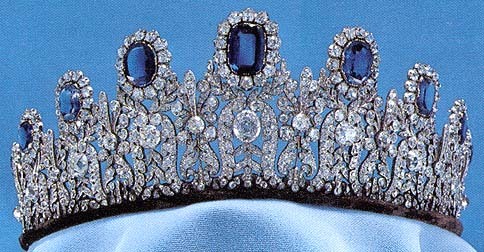
In her will, Princess Augusta is said to have left the sapphires to her eldest daughter Joséphine, who married King Oscar I of Sweden and Norway. Today, the parure is Queen Silvia of Sweden’s signature set of jewels.

The complete Leuchtenberg sapphire parure
The parure is considered one of the most beautiful displays ever of jewelry craftsmanship and also one of the most complete, containing a tiara, necklace, earrings, brooch and four hairpins, two of which have been incorporated into earrings since the original earrings were supposedly separated from the set. The tiara itself consists of 11 separate sections, which means it can be worn in virtually any form, from a diadem to a crown, and adjusted to perfectly fit the shape of the wearer’s head. The tiara showcases 11 large, rectangular-shaped deep-blue sapphires set on a base of honeysuckles and leaves crafted from 11 oval-shaped diamonds and hundreds of smaller diamonds. As another testament to its remarkable design, the sapphires can be switched out for other gemstones.
The Dutch sapphire tiara

The Dutch sapphire tiara On Queen Beatrix and Queen Maxima
Purchased in 1881 by King Willem III of the Netherlands for his wife, Queen Emma, the Dutch Sapphire Tiara is utterly extravagant. Featuring 33 blue sapphires and 655 diamonds, set in platinum, the tiara resembles the Gothic architecture of a great cathedral with sparkling stained glass windows.
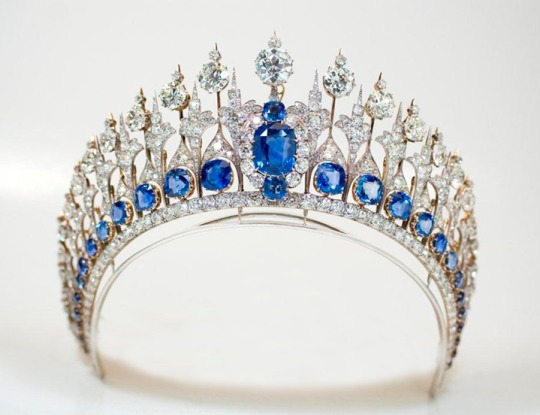
Several of the stones are also mounted en tremblant, meaning they’re attached to a trembler, or a material that acts like a spring, to create movement when worn and reflect the surrounding light. A necklace, two bracelets and a brooch were later added to create a parure. Queen Máxima of the Netherlands recently streamlined the tiara, redesigning the central diamond element for a more modern look.

Queen Victoria’s sapphire coronet
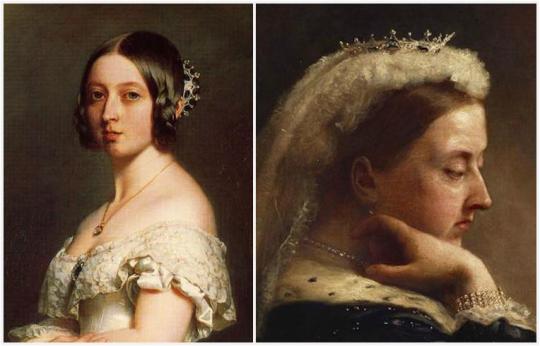
Queen Victoria wearing her sapphire coronet in official portraits
Perhaps what makes Queen Victoria’s Sapphire Coronet so special is that Victoria’s husband, Prince Albert, with whom she was very much in love, designed it for her. In fact, the petite coronet was reportedly one of the only pieces Queen Victoria decided was appropriate to wear during her widowhood.

Most likely commissioned from Joseph Kitching in 1842, the coronet features a flexible Gothic design with both cushion- and kite-shaped blue sapphires set in yellow gold, as well as diamonds set in silver, for a less ostentatious look the new princess might prefer. The coronet passed on to Princess Mary, who was given the coronet, along with a matching parure, as a wedding gift from her father, King George V, Victoria’s grandson. It was reportedly last seen in 2002 at an exhibit at the Victoria and Albert Museum in London.

Queen Marie-Amélie’s sapphire and diamond parure tiara

On The Left : A Portrait of Queen Marie. On the right : A Portrait of Princess Isabelle of Orleans-Braganza wearing the sapphire and diamond crown.
“Perfect” is how the craftsmanship is described for Queen Marie-Amélie’s Sapphire and Diamond Parure. Most likely the original property of Empress Joséphine, wife of Emperor Napoléon I, it entered the collection of Queen Marie-Amélie de Bourbon when Hortense de Beauharnais, Joséphine’s daughter, sold it in 1821 to the Queen’s husband, King Louis-Philippe of France.
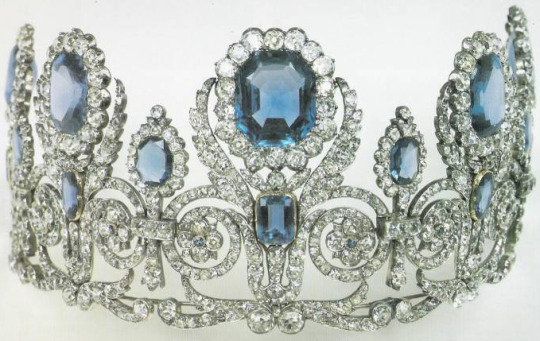
The parure remained within the royal French family until they sold it to the Louvre in 1985. The parure’s tiara is exquisite, featuring large blue sapphires from Sri Lanka (formerly Ceylon) and diamonds set in white gold, with pieces that can be worn independently as brooches. At some point, the tiara was reduced in size, and is displayed in the museum along with the parure’s matching necklace of large oval-shaped blue sapphires encircled with diamonds and separated by articulated diamond “strings,” earrings, one large brooch and a pair of smaller brooches.

Queen Marie-Amélie’s sapphire, diamond and pearl parure tiara

Queen Marie-Amélie had a second sapphire parure, which included diamonds as well as pearls. Created for her by French royal jeweler Bapst from existing jewels in her collection, the tiara features seven oval-shaped blue sapphires said to be of Sri Lankan origin with graduated-diamond surrounds atop diamond festoons accented with pearls and blue sapphires.
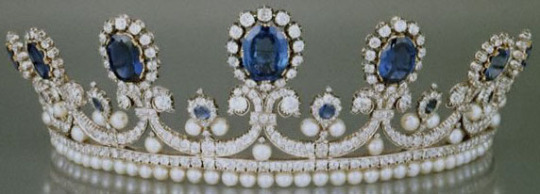
The parure also includes earrings, three brooches (including two epaulette brooches) and a belt buckle or the center plaque of a bracelet. Like the Queen’s sapphire and diamond parure, this one remained within the French royal family until it was sold in the 1990s. The setting of the blue sapphires and diamonds in both of Marie-Amélie’s tiaras closely resemble Kate Middleton’s engagement ring, first given to Princess Diana of Wales, a natural design choice for the new princess to honor both her mother and grandmother.
The Barberini sapphire parure tiara

The Barberini Sapphire Parure, with its free-form floral motif, offers a refreshing design change from the more architectural pieces. Belonging first to the Barberini family of Italian nobility, which rose to prominence in the 17th century, the matching set includes a blue sapphire and diamond tiara, necklace, girandole earrings and brooch.

The tiara, which dates from around 1850, resembles a wreath of flowers composed of a rose-cut diamond branch blossoming with old-cut diamond flowers and collet-set blue sapphire centers and buds set in gold and silver. It has a light and airy quality that’s feminine and romantic, just what you would expect the new princess to fancy. The parure was reportedly last sold at auction in four separate pieces for a combined total of $250,000, of which $100,144 was for the tiara alone.
The Nassau tiara

Princess Stephanie wearing the Nassau sapphire & diamond tiara
The Grand Duchess Adelaide Tiara is said to have been part of the trousseau of Princess Adelheid-Marie of Anhalt-Dessau, Grand Duchess of Luxembourg, the second wife of Adolphe, Grand Duke of Luxembourg, who ruled Luxembourg from 1890–1905. It’s most closely associated with her granddaughter, Grand Duchess Marie-Adélaïde, who favored the tiara when sitting for photographs or paintings during her reign from 1912–1919. Created between 1865 and 1870, the tiara features a large cushion-shaped blue sapphire at the center, which can be removed and worn separately.

Surrounding the sapphire is a leaf-and-berry motif crafted from brilliant- and rose-cut diamonds set in white and yellow gold. Two loops at the base of the tiara can attach an additional element. The tiara passed on to Marie-Adélaïde’s sister and successor, Grand Duchess Charlotte, and has since been seen on Maria Teresa, the current Grand Duchess of Luxembourg, her daughter-in-law, Princess Tessy of Luxembourg and Princess Stephanie. The new princesses might appreciate the timeless design of a tiara such as this, which has been beloved by the Luxembourg royal family for more than a century.
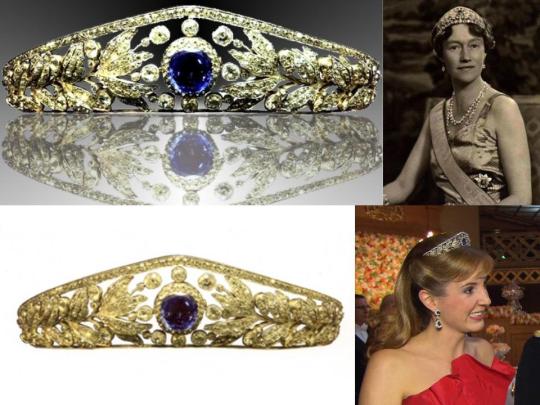
The Océan Tiara

Princess Charlene’s ocean tiara designed By Van Cleef & Arpels
Commissioned by Prince Albert II of Monaco as one of several wedding gifts for his new bride, Princess Charlene Wittstock. Created by renowned jeweler Van Cleef & Arpels, the tiara pays homage to Charlene’s South African heritage as well as her status as an Olympic swimmer. Its design features a sea-spume motif fashioned from more than 850 diamonds of the highest quality and 359 sapphires in graduated shades of blue evoking the different seas of the world, from the waters off the coast of Monaco to the ocean around South Africa. To crown the work, 11 pear-shaped diamonds represent water droplets. The largest of these, at more than four carats, is of incomparable beauty, with D color and an internally flawless clarity. What’s even more remarkable about this piece is that the tiara doubles as a necklace and also features removable elements that can be worn separately.
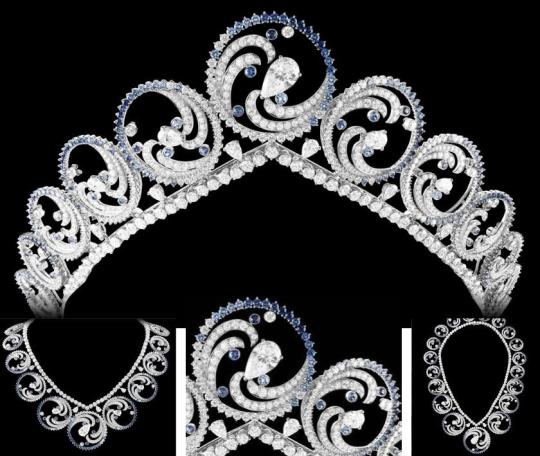
Maria Feodorovna’s sapphire bandeau

Princess Margaret wearing the sapphire bandeau
In the style of the Grand Duchess Adelaide Tiara, Maria Feodorovna’s Sapphire Bandeauis grand but not too lavish, featuring a starburst pattern of diamond rays radiating from a central blue sapphire. Some say the tiara originally belonged to Maria Feodorovna, Princess Dagmar of Denmark, the wife of Alexander III, who was Emperor of Russia, King of Poland and Grand Prince of Finland from 1881–1894. The Empress had a vast collection of jewelry that dispersed after her death, so if the tiara belonged to her, perhaps that’s how it fell into the possession of Queen Mary, wife of King George V of the United Kingdom and the British Dominions, and Emperor of India, from 1910–1936. Mary left the tiara to Queen Elizabeth The Queen Mother, who often gave it to her daughter Princess Margaret to wear. While Queen Elizabeth has never worn this tiara in public, as part of the jewels owned personally by the monarchy of the United Kingdom.

17 notes
·
View notes
Photo
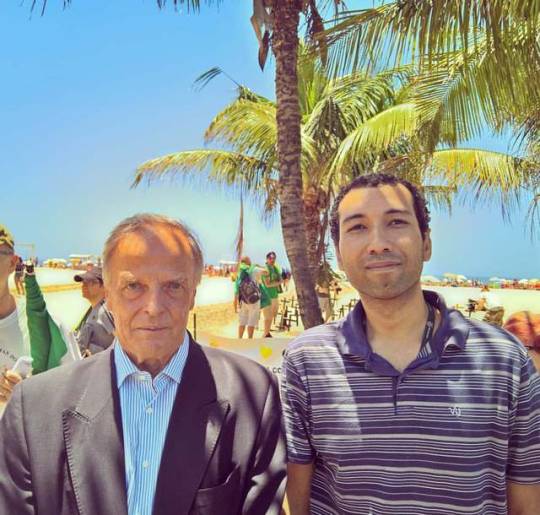
Eu e Sua Majestade, o príncipe Imperial do Brasil, Dom Antônio da Casa dos Orleans e Bragança. Yo y su majestad, el príncipe imperial de Brasil, Dom Antônio de la casa de Orleans y Braganza. I and His Majesty, the Imperial Prince of Brazil, Dom Antônio of the House of Orleans and Braganza. #imperiodobrasil #emperebrazil #brasil #brazil #copacabana #instagram #lumiaphotography #lumia950xl #lumia950xlphotography #w10m #lumialove #riobeach #riodejaneiro #monarch #monarchy #princess #principe (em Copacabana Rio De Janeito-Rj)
#lumia950xl#principe#brazil#lumiaphotography#lumialove#monarchy#monarch#brasil#instagram#emperebrazil#riodejaneiro#lumia950xlphotography#princess#w10m#riobeach#copacabana#imperiodobrasil
0 notes
Photo


Princess Pedro de Alcântara of Orléans-Braganza (born Countess Elisabeth Dobrženský of Dobrženitz) with her five children, Isabelle, Pedro Gastão, Maria Francisca, João Maria and Teresa of Orléans-Braganza.
#Princess of Orleans-Braganza#Princess Isabelle of Orleans-Braganza#Countess of Paris#House of Orleans#House of Braganza#French Royalty#Brazilian royalty#Princess#History
14 notes
·
View notes
Text

Prince Rafael of Orléans-Braganza.
#monarquias americanas#império do brasil#brazilian empire#imperial house of brazil#dom rafael de orleans e bragança#orleans bragança#orleans braganza#house of braganza#casa de bragança
5 notes
·
View notes
Photo
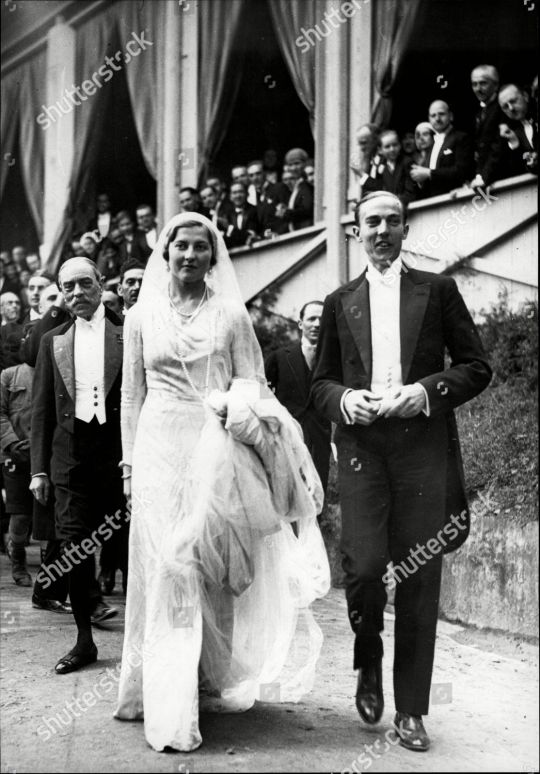
✵ April 8, 1931 ✵
Princess Isabelle of Orleans-Braganza & Prince Henri, Count of Paris
#Princess Isabelle of Orleans-Braganza#Princess Isabelle#House of Orleans-Braganza#prince henri#countess of paris#count of paris#House of Paris#wedding dress#royal wedding dress#wedding dress train#royal wedding train#royal wedding dress train#royal wedding veil#Wedding Veil#france#french royalty#french royal family#french royal wedding#house of orleans#Royal Wedding
8 notes
·
View notes
Photo

The Count and Countess of Paris descend the staircase at the Royal Palace of Athens during the pre-wedding ball of the Prince of Asturias and Princess Sophia of Greece, 1962.
#french royalty#house of orleans#henri of orleans#isabelle of orleans braganza#royal#style#royal jewels#vintage#elegance
18 notes
·
View notes